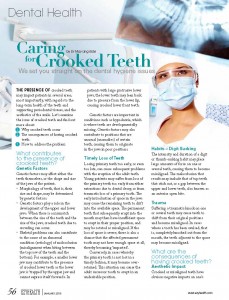 This article first appeared in the January 2015 issue of Ezyhealth magazine. We have reproduced it for the information of those of you who missed it when it was published.
This article first appeared in the January 2015 issue of Ezyhealth magazine. We have reproduced it for the information of those of you who missed it when it was published.
The presence of crooked teeth may impact patients in several areas, most importantly, with regards to the long-term health of the teeth and supporting periodontal tissues, and to the aesthetics of the smile. Let’s examine the issue of crooked teeth and find out more about:
1. Why crooked teeth occur
2. The consequences of having crooked teeth
3. How to address the problem
WHAT CONTRIBUTES TO THE PRESENCE OF CROOKED TEETH?
Genetic factors
Genetic factors may affect either the teeth themselves, or the shape and size of the jaws of the patient.
- Morphology of teeth, that is their size and shape, may be determined by genetic factors.
- Genetic factors play a role in the development of the upper and lower jaws. When there is a mismatch between the size of the teeth and the size of the jaws, crooked teeth due to crowding can occur.
- Skeletal problems can also contribute to the cause of an abnormal condition (aetiology) of malocclusion (misalignment when biting between the top row of the teeth and the bottom). For example, a smaller lower jaw may contribute to the presence of crooked lower teeth as the lower jaw is ‘trapped’ by the upper jaw and cannot express itself forwards. In patients with large protrusive lower jaws, the lower teeth may lean back due to pressure from the lower lip, causing crooked lower front teeth.
Genetic factors are important in conditions such as hypodontia, which is where teeth are developmentally missing. Genetic factors may also contribute to positions that are unusual (anomalies) of certain teeth, causing them to originate in the jaws in poor positions.
Timely loss of teeth
Losing primary teeth too early, or even too late, can cause subsequent problems with the eruption of the adult teeth. Young patients who suffer from loss of the primary teeth too early may do so from either extractions due to dental decay, or from traumatic loss of a primary tooth. The early introduction of space in the jaws may cause the remaining teeth to drift into the available space. The permanent teeth that subsequently erupt into the mouth may then have insufficient space to erupt in their proper position, and may be rotated or misaligned. If the amount of space loss is severe, there is also a chance that the affected permanent tooth may not have enough space at all, thereby becoming ‘impacted’.
Conversely, in cases whereby the primary tooth is not lost in a timely fashion, it may become over-retained. This situation can cause the adult successor tooth to erupt in an undesirable position.
Habits – Digit Sucking
The intensity and duration of a digit or thumb-sucking habit may place large amounts of force on one or several teeth, causing them to become misaligned. The malocclusion that results may include that of top teeth that stick out, or a gap between the upper and lower teeth, also known as an anterior open bite.
Trauma
Suffering a traumatic knock on one or several teeth may cause teeth to shift from their original positions and become misaligned. In cases where a tooth has been avulsed, that is, completely knock out from the mouth, the teeth adjacent to the space may become misaligned.
WHAT ARE THE CONSEQUENCES OF HAVING CROOKED TEETH?
Aesthetic impact
Crooked or misaligned teeth have obvious negative impacts on one’s smile. In severe cases, some patients may even appear to have missing or malformed teeth due to the severity of misalignment. Having misaligned or crooked teeth may affect a person’s self-esteem, causing them to be more self-conscious about their smile and facial appearance.
Functional problems
Having misaligned teeth can pose functional problems for patients. For example, in cases where the patient has a reverse bite of one or several teeth, the patient may tend to shift their bite forwards or to the side upon contact with the tooth/teeth. This can cause long-term problems not only to the affected tooth, but potentially also to the temporomandibular joints (TMJ) of the patient.
Difficulties maintaining good oral hygiene
Scientific research tends to support the notion that patients can have excellent oral hygiene despite having crooked teeth. However, clinical experience shows that the inability to clean effectively between overlapping teeth can result in a greater risk of developing decay between the teeth. The subsequent restoration of these teeth may also prove to be difficult to achieve as well as to maintain, especially if the oral hygiene measures remain poor.
Not being able to clean efficiently or floss well between crooked teeth can lead to problems that are more severe than just gingivitis. The bacteria in the plaque around misaligned teeth can cause problems to the supporting bone and periodontal tissues, which can lead to eventual bone loss, mobility of teeth, and even tooth loss.
WHAT CAN BE DONE TO ADDRESS THE PROBLEM OF CROOKED TEETH?
Preventative measures
Regular dental check-ups with timely radiographic investigations are the most important preventative measures that parents can take for their children. Regular dental check-ups allow the dentist to educate families and children with the appropriate dietary and oral hygiene advice. As mentioned before, although dental hygiene measures may be more difficult to carry out in patients with very crooked teeth, good toothbrushing and flossing techniques are still possible.
Preventing dental decay and early loss of primary teeth will ensure that the primary teeth act as natural space maintainers for the adult teeth.
There are certain developmental milestones that dentists can look out for in children with regarding to their teeth. Radiographic and clinical investigations would be necessary if these developmental milestones are not met.
Appliances such as space maintainers may be considered in cases where primary or permanent teeth have been lost early. This can prevent unwanted drifting of adjacent teeth into an available space if a tooth has been lost prematurely due to decay or trauma.
Interceptive measures
Interceptive orthodontic measures are considered a phase of treatment concerned with elimination of a particular condition that may subsequently lead to a malocclusion. Interceptive orthodontic measures may prevent or reduce the need for definitive orthodontic treatment in the future. Interceptive orthodontic measures may prevent or reduce the need for definitive orthodontic treatment in the future.
Types of interceptive measures include:
- Habit-breaker appliances
- Appliances to correct a crossbite.
The appliance chosen for use may be removable or fixed onto the teeth.
Definitive orthodontic treatment
Definitive orthodontic treatment is generally begun when the patient is in the late mixed dentition, or permanent dentition. This phase of orthodontics will address the major concerns of the patient and dentist. The most common types of appliances used in orthodontic treatment are:
- Functional appliances
- Fixed orthodontic braces
- Clear aligner appliances such as Invisalign
 Dr May Ling Eide is a dental surgeon with Postgraduate Training in Orthodontics with Specialist Dental Group®. She received her specialist training in orthodontics from the University of London, United Kingdom and is registered as an Orthodontist on the Specialist List of the General Dental Council in the United Kingdom. For more information, visit www.specialistdentalgroup.com
Dr May Ling Eide is a dental surgeon with Postgraduate Training in Orthodontics with Specialist Dental Group®. She received her specialist training in orthodontics from the University of London, United Kingdom and is registered as an Orthodontist on the Specialist List of the General Dental Council in the United Kingdom. For more information, visit www.specialistdentalgroup.com





